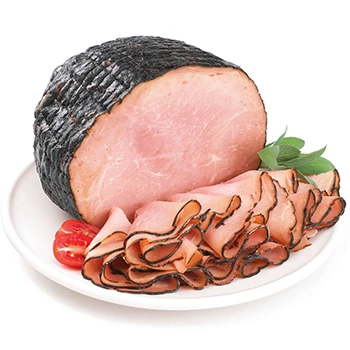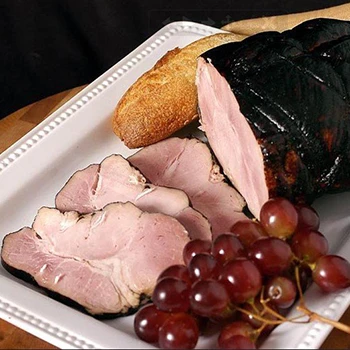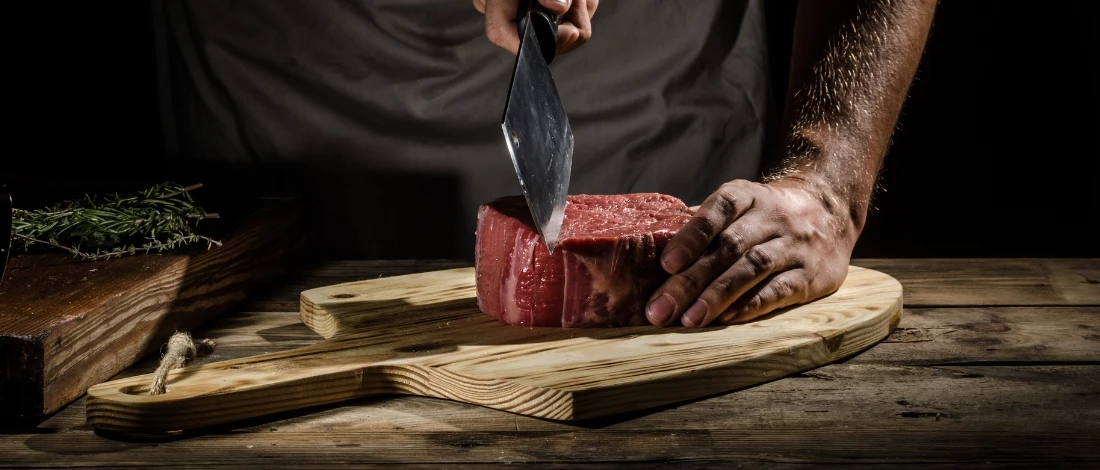One of the most exciting things about being a dedicated carnivore lifestyle adherent is that you have the opportunity to try delicious meats from all over the world.
I did a ton of online research using reputable online sources and consulting with experienced nutritionists. I finally understood how this meat is made, what its nutritional value is, and its health benefits.
This article will share my insights on what black forest ham is and highlight 6 health facts and its culinary uses.
Quick Summary
- Black forest ham is a type of cured meat originating from the Black Forest region in Germany.
- It is made from the leg cut of a pig that is dry-cured with salt and other seasonings.
- The ham is then smoked over spruce, fir, or pine wood, giving it a distinctive smoky flavor.
What is Black Forest Ham?

Black Forest ham is a deli ham that has been smoked and cured using traditional methods. This ham is known for its distinctive flavor, pronounced taste, and rich texture.
It is typically sliced thin and served as deli meats in sandwiches or as part of a meat and cheese platter.
The Black Forest area of southwestern Germany, known for its dense woodlands, has a rich tradition of producing smoked and cured meats.
For centuries, farmers in the area have cured and smoked hams using a mixture of salt, pepper, coriander, and other spices.
Hans Alder developed the original Black Forest ham in Bonndorf, Germany, in 1959 [1].
He salted, cured, and smoked the meat using a century-old recipe. This traditional curing and smoking process effectively extended the ham's shelf life while also imparting a distinctive, rich aroma to the product.
In 1997, the European Union recognized "Black Forest ham" as a "protected geographical indication" [2].
This scheme safeguards and promotes agricultural foods with distinct, authentic qualities and protected designations of origin.
Related Articles:
Ingredients and Preparation
The main ingredient in the Black Forest smoked ham, or "Schwarzwälder Schinken" in German, is the hind leg of a pig.
The leg is first cleaned and then seasoned with salt, pepper, garlic, coriander, and other spices. Some recipes also use juniper berries to add an additional layer of rich flavor.
The boneless ham is left to cure for several weeks in a cool, dry environment. The salt and spices extract moisture from the ham during this time and add flavor.
Traditionally, the salt is removed from the meat, and the ham is left to age for two or more weeks to produce more intense flavors.
After the curing process, the raw ham is rinsed and hung in a smokehouse.
The cold-smoking process can take several days, during which the ham is exposed to smoke from wood and sawdust from local conifers. This gives the ham its distinct smoked flavor.
Finally, the ham is ripened under climate-controlled conditions for several weeks, finalizing the meat's dark color and firm texture. The entire process may take up to three months.
"Black Forest ham is a culinary marvel that is a testament to the rich culinary traditions of Germany."
- Wolfgang Puck, Austrian-American Chef
Flavor Profile & Culinary Uses of Black Ham

Traditional Black Forest ham is known for its rich, nutty, and smoky flavor. It has a salty and slightly sweet taste complemented by the spices used in the curing process.
The ham has a tender texture that is easy to slice, making it a popular choice for making ham sandwiches or salads.
In addition to being used in cold meals, Black Forest ham can be used in cooked dishes.
It is an excellent addition to pasta dishes, quiches, and omelets. Black Forest can also be used as a food topping to produce pizza and flatbreads.
Slices from Black Forest hams pair well with cheese, fruit, and crackers, offering a perfect snack for any occasion.
Black Ham Health Benefits & Nutritional Value
Delicious Black Forest ham is high in protein, low in carbohydrates, and contains low calories.
It is also a good source of vitamins and minerals such as iron, niacin, and zinc [3].
Like other cured meats, it can have a high sodium nitrite content, so I only eat it in moderation.
A typical 100-gram serving of black forest ham contains the following nutritional value:
- Energy: 107 calories
- Protein: 17.9 g
- Total Fat: 2.68 g
- Saturated Fat: 0.89 g
- Cholesterol: 54 mg
- Sodium: 1040 mg
Labeling and Certification

A Protected Geographical Indication certification regulates the traditional Black Forest ham.
This ensures that the ham is cured according to traditional methods in the Black Forest region of Germany.
The ham must also be made using pork from the area and be smoked using only the woods found in the Black Forest.
In addition, the ham must undergo a strict certification process to ensure that it meets the quality standards set forth by the German government.
FAQs
What Is the Difference Between Smoked Ham and Black Forest Ham?
The difference between smoked ham and Black Forest ham is that Black Forest ham is cold-smoked over coniferous wood, while smoked ham is most often apple, oak, or hickory smoked.
Why Do They Call It Black Forest Ham?
They call it Black Forest ham because it is made in the Black Forest section of Germany and cured with a mix of spices that give it a distinctive dark coloring.
References:
- https://www.adlerschwarzwald.de/us/history/
- https://www.tmdn.org/giview/gi/EUGI00000013046
- https://fdc.nal.usda.gov/fdc-app.html#/food-details/2027343/nutrients








